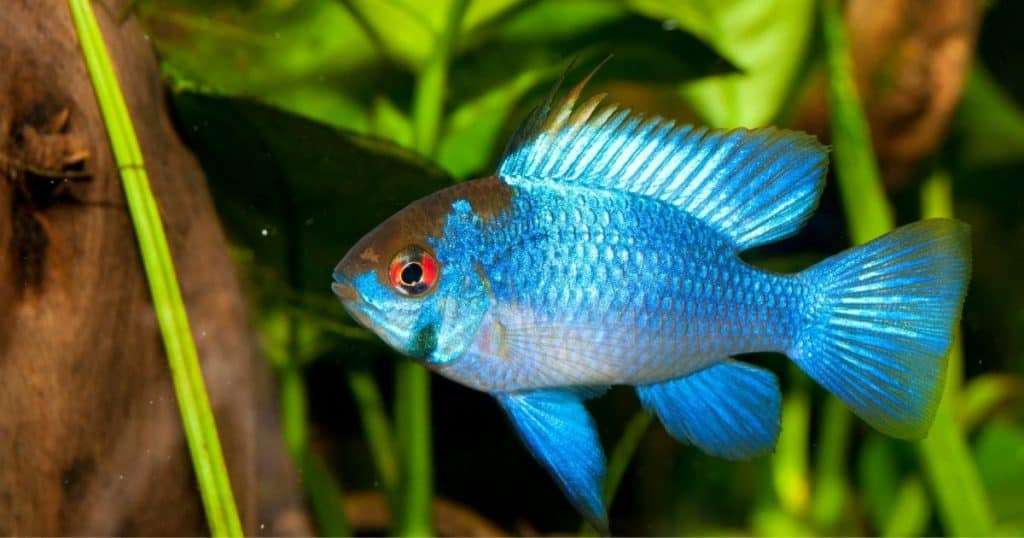
Size
An adult’s typical height and width are 1.4 to 1.6 inches.
Physical characteristics and behavior
The belly of the Electric Blue Ram is spherical and laterally compressed. This species is easily recognised thanks to its vibrant color. It stands out even more due to how quickly its hue can change depending on the animal’s emotions. The exquisite specimens of this species are mainly yellow with vertical bands of black or brown. This species frequently has tiny bluish spots dispersed across its body in addition to the black vertical stripe that runs across its eye.
Habitat
Water that is between 78 and 85 degrees Fahrenheit in temperature is ideal for Electric Blue Ram. Individual electric blue rams bred in aquariums usually adapt to any pH value below 7.1. However, these fish do well in a pH range of 5 to 6.
Keeping as Pet

- Tank Size
Even though they are little, electric blue rams are a busy fish that require a reasonably large aquarium. For one fish or a pair of fish, you’ll need an aquarium that is at least 20 gallons. Each additional fish need an additional 10 litres of water. For instance, you’ll need at least a 40-gallon tank if you want to keep 4 electric blue rams. When they reach sexual maturity, electric blue rams, like most cichlids, can become aggressive toward other members of their own species, thus a larger tank can help diffuse the conflict. Additionally, a large tank is required if you intend to keep other fish species alongside your ram cichlids so that each fish has enough room to swim.
- Tank Setup
The perfect tank setup is equally as crucial to the happiness of your blue ram cichlids as the proper tank size. You should make sure your tank has an aquarium heater because the species is native to a warm climate. Maintaining steady water parameters and a clean tank depend on effective filtration. Make sure German rams have lots of living plants to hide behind because they can be quite skittish. To add tannins to your water, you may also add driftwood and Indian almond leaves.
Given that the species spends a lot of time at the bottom foraging for food, the substrate should be fine sand or gravel. Dark substrate might assist your fish’s color appear brighter, so it’s something to think about.
- Tank mates
Electric blue rams should live in a community tank with other quiet little species of fish that have comparable water needs because of their tranquil nature. Fish that are loud and aggressive might quickly stress them out. Dwarf gouramis, kuhli loaches, cory catfish, bristlenose plecos, and small tetra species make good electric blue ram tank mates. German blue rams are not often good friends with aquatic snails and prawns since they make a delicious snack!
- Diet
In the wild, the omnivorous german electric blue ram consumes plant debris, tiny invertebrates, and insects. To improve their immunity and color, these fish should be kept in captivity and fed a range of freeze-dried, frozen, and live feeds. In addition to brine shrimp, bloodworms, tubifex food, and the occasional leafy green vegetable, you can give rams high-quality fish flakes or pellets. Make sure the food is bite-sized so that it can go in their mouths. Rams that are electric blue can be fed two to three small meals each day. Give your fish only as much food as they can consume in about 2 minutes, and then discard the rest.
Table





